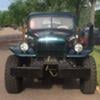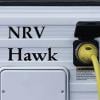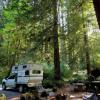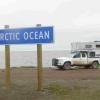FWC Single Sheet Roof "Tin Canning"...Why?
#61

Posted 31 May 2023 - 05:30 PM
Jon R
2021 Grandby Slide-in Front Dinette
2021 GMC 3500HD CC LB SRW Gas
1993 Chevrolet K2500 Ext Cab LB
#62

Posted 31 May 2023 - 09:58 PM
Good thinking by many on this...would add that wind direction varies as does velocity during the tin canning.. My experience although not well defined is that wind coming from a frontal direction cause more tin canning that from abeam. No hard data points.
Hatching a plan to put lateral flat aluminum bar between my Yakima rails and using the rails as removable attachment points [no idea of how to attach but have bar stock flat against the top] so I can vary them in an attempt to determine exactly where the top sheet needs the bars...Since rails are screwed to frame and bars are flat it should not create unwanted movement or tension on the rails.
Turbulent air vs laminar flow is an unknown and while I do wish to stop the TCing I will try to avoid creating drag on the roof, imperil my solar panels while driving or adding significant weight to the top . Kinda of operating from a "do no harm" position.
Testing any retro fix for this issue will be a bear; unless I can find a wind tunnel to use.... ![]()
Edited by Wallowa, 31 May 2023 - 10:00 PM.
#63

Posted 01 June 2023 - 02:26 AM
If you can reliably repeat the problem, use weights to locate optimal placement (sand bags, bar bell weights, etc.). The closer to the crest(s) and trough(s) you can get the better the results.
Then I would use a product designed to dampen vibration like Dynamat, Kilmat, et.al. aluminum/butyl or lead/butyl self adhesive mats.
#64

Posted 01 June 2023 - 04:37 AM
JaSan,
CLD tiles might work well. I used the CLD tles from Sound Deadener Showdown to help damp the sound in my truck cab. But SDS is gone )owner retired). The tiles from Resonix seem to be as good, perhaps better.
See here
https://resonixsound...ound-deadening/
If you need to do any kind of sound damping I recommend looking at the products these folks sell. Prices are a lot more reasonable on a per db damping perspective than other products like Dynamat.
https://resonixsound...t-testing-data/
I hope this is helpful,
Craig
1993 Dodge Cummins W-250 Club Cab long bed, 2007 FWC Keystone
#65

Posted 01 June 2023 - 05:12 PM
For another data point, I tried Jon's experiment on my 2016 Hawk roof (pulling up on the roof using gaffers tape). My roof doesn't have any penetrations except the two vents and the solar connector. No Yakima rails, no solar panels. I've never had any appreciable oil canning, at least not enough to bother me, despite having camped in windstorms strong enough for the sound of the vinyl walls billowing in the wind to keep me awake.
It's clear that on my camper, the roof is still firmly bonded to the aluminum longitudinal frame members. I was surprised by how much the roof sagged in the center (between the frame along the vents and the frame towards the passenger side). I was able to pull that area up almost an inch.
Inside the camper, I tried pushing up on the headliner. In most places, it's clear that the insulation is not bonded to the roof. In those places, it was easy to push the insulation panels up until I felt them contact the roof. It seems that the insulation panels are loose and resting on the headliner. The area where I noticed the roof sagging from the top was one of the areas where the panels seemed loose. I did find one or two spots where it did seem that the insulation was still attached to the roof, but most of the insulation panels seemed to be loose.
I'm guessing that my 2016 Hawk was manufactured after FWC started adhering the insulation panels to the roof to minimize oil canning, as Stan mentioned. So my conclusion is that the adhesive between the panels and the roof has failed in my camper. Possibly that might have happened due to differing thermal expansion of the polystyrene and aluminum. I think that generally for that combination of materials you'd want a fairly thick layer of adhesive with a good amount of elasticity when cured, in order to handle shear stresses due to differential expansion.
I think that if I start having problems with oil canning, the first thing that I would try would be to open up the headliner and reattach the insulation panels.
As others have noted, surface prep is critical when using adhesives. The adhesive manufacturers have spent a lot of time and money developing optimal application processes for different materials, so following their recommendations goes a long way to having durable adhesive bonds.
- Rusty
Rusty
New River Valley, VA
#66

Posted 01 June 2023 - 06:26 PM
I also can see quite a bit of sag between the frames after two years compared to what I recall it looking like just after delivery when I put my solar panels on. My roof has never had snow on it. I have not experienced oil canning noise, but I have not yet camped in high winds either.
Jon R
2021 Grandby Slide-in Front Dinette
2021 GMC 3500HD CC LB SRW Gas
1993 Chevrolet K2500 Ext Cab LB
#67

Posted 01 June 2023 - 07:34 PM
I counted 36 screws (40 if you count the ones I added for the rack). That's a lot of potential leak points. Some people prefer the two piece roof over the one piece. I don't have oil canning but I have resealed the roof twice. If I were in the market for a new camper I'd have to think hard about which way to go.
Craig K6JGV_________________________ 2004 2500 CTD 4X4 FWC HAWK 1960 CJ5
#68

Posted 03 June 2023 - 02:46 PM
I personally would take a 1 piece roof over a 2 piece (with screws and a seam) even with the "tin canning".... I bet there are a few cases where the 2 piece roof leaked and having one with screws and the amount of maintenance required, I'll take the 1 piece.
Wallowa,
I agree it is not feasable to replace the roof. My statement is aimed more at FWC. They prefer to keep the smooth look and single piece despite this known issue and the fact that the seam in the two piece roofs never leaked. I don't have an answer as to what to do as it was never resolved in our camper.
You can get pieces of aluminum like that at places like Lowes and Home Depot, but only in shorter lengths. I think 3' and maybe 6' might be it. Not sure if that would be long enough, but if it is then the cost of shipping is the gas you use to drive there.
Boise, ID
2022 Chevy 3500 HD
2023 FWC Flatbed Hawk
#69

Posted 03 June 2023 - 06:31 PM
The 2-piece roof was replaced on our 2005 Eagle with the 1-piece roof, and I no longer needed to reseal the screws every year or two. Our first encounter with roof leaks, of course, happened early in week spring trip in the Pacific North Wet. We now have a 2015 Hawk and have not had any leaks and, fortunately, no canning.
Seems to me that if you need to screw down a 1-piece, you are no worse off than the 2-piece roof when it comes to leak prevention.
Check out Metals Supermakets, https://www.metalsupermarkets.com/
for aluminum and other metal stock. Cheaper than Home Depot or Lowe's and they cut to order, usually same day or next day. They have stores in most major cities and do online as well.
2015 Fleet on 2019 Ranger
#70

Posted 03 June 2023 - 09:14 PM
Question:
Those you with tin canning noises and with a single top sheet....have you ever had a snow load on that roof?
Thanks...Phil
[Reason for question to follow.... ![]() ]
]
0 user(s) are reading this topic
0 members, 0 guests, 0 anonymous users


















